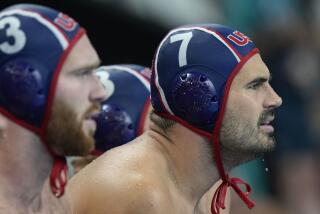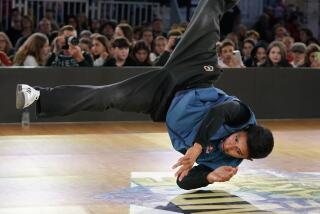En Garde: Olympic Hopefuls Duel for Spots on U.S. Team : Top Swordsmen From Each Weapon Category in Trials at Pierce College
- Share via
If the Calgary Games left you brimming with Olympic spirit but you’d like to watch an event from someplace other than your sofa, venture to Woodland Hills this weekend to see nearly 300 swordsmen duel for a spot on the U.S. Olympic fencing team.
Only a third of the athletes have any real chance to make the squad that will travel to the Summer Games in South Korea. “But everyone will be fencing like there’s a gold medal on the line,” promises Frank Widder, a competing fencer and spokesman for the United States Fencing Assn.
The competition will be held in the men’s and women’s gyms at Pierce College, 6201 Winnetka Ave., Woodland Hills. There’s no admission charge.
Trials in Three Categories
The trials include all three “weapons” in the sport of fencing: The lightweight, flexible foil; the heavier, stiffer epee, and the cavalry-like sabre.
Trials began Friday and run through Sunday. Competition starts at 9 a.m. each day, with finals in the epee expected to begin about 5 p.m. today. Foil finals should begin about 5 p.m. Sunday and sabres at 7 p.m. Sunday.
The favorite going into the sabre competition is No. 1-ranked Peter Westbrook of New York, who won a bronze medal in the 1984 Olympics. It was the first Olympic medal a U.S. fencer had taken home in 24 years.
The foil competition draws Peter Lewison of New York, currently No. 1, and Michael Marx of Indiana, defending U.S. foil champion.
Fencers who do well in the Woodland Hills trials score “qualifying points” used to determine the Olympic team.
The competition provides a rare chance for Southlanders to see the nation’s top-ranked fencers, Widder said. “Most trials are held in the Midwest or East because that’s where most of the best fencers and coaches live.”
If you haven’t watched fencing before, Widder suggests starting out by focusing on just one of the two swordsmen. The one being attacked defends himself with a “parry” to deflect his opponent’s blade, and then makes a “riposte,” or answering attack.
The two adversaries constantly change from defense to offense until one scores a hit. Generally, the first fencer to score five or 10 touches wins.
You might think a sword fight is a sword fight, but each type of fencing has its own set of rules.
In epee, a fencer scores by hitting any part of his opponent’s body. In sabre, the target is an arm or anything above the hips.
Similar Targets in Foil
The target in foil is much like the target in sabre, with three exceptions: The arms and head don’t count, but the groin area does.
As opponents fence, they must remain on a padded strip about 46 feet long and 7 feet wide. A touch doesn’t count if it’s made by a swordsman who is off the strip, and a fencer who strays too far away has a point taken away from him.
Sunday has been proclaimed “Fencing Day” by the City of Los Angeles, Widder said, chosen because it’s the anniversary of Cyrano de Bergerac’s birthday.
Although Bergerac is best-known as the large-nosed poet in Edmond Rostand’s play, he actually lived in the 17th Century and was a soldier whose swordsmanship was legendary.
More to Read
Go beyond the scoreboard
Get the latest on L.A.'s teams in the daily Sports Report newsletter.
You may occasionally receive promotional content from the Los Angeles Times.






